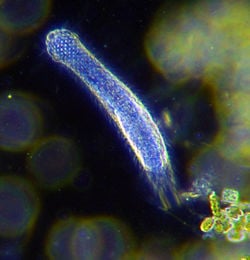Difference between revisions of "Gastrotricha" - New World Encyclopedia
Rick Swarts (talk | contribs) |
Rick Swarts (talk | contribs) |
||
| Line 27: | Line 27: | ||
* Ramel, G. 2008. [http://www.earthlife.net/inverts/gastrotricha.html The Phylum Gastrotricha]. ''Earth-Life Web Productions''. Retrieved June 5, 2008. | * Ramel, G. 2008. [http://www.earthlife.net/inverts/gastrotricha.html The Phylum Gastrotricha]. ''Earth-Life Web Productions''. Retrieved June 5, 2008. | ||
| − | * Todaro, M. A. | + | * Todaro, M. A. 2006. [http://www.gastrotricha.unimore.it/overview.htm Gastrotricha: Overview]]. ''University of Modena and Reggio Emilia''. Retrieved June 5, 2008. |
| − | * Todaro, M. A. | + | * Todaro, M. A. 2008. [http://www.gastrotricha.unimore.it/systematics.htm Gastrotricha: Systematics]. ''University of Modena and Reggio Emilia''. Retrieved June 5, 2008. |
Revision as of 21:51, 5 June 2008
| Gastrotrichs | ||||||||||
|---|---|---|---|---|---|---|---|---|---|---|
 Darkfield photograph of a gastrotrich.
| ||||||||||
| Scientific classification | ||||||||||
| ||||||||||
|
Macrodasyida |
The gastrotrichs (from Greek gaster "stomach" and thrix "hair") are a phylum of microscopic (0.06-3.0 mm) animals abundant in fresh water and marine environments. Most fresh water species are part of the periphyton and benthos. Marine species are found mostly interstitially in between sediment particles. They are bilaterally symmetric, with a complete gut. They demonstrate eutely, with development proceeding to a particular number of cells, and further growth coming only from an increase in cell size. The body is covered with cilia, especially about the mouth and on the ventral surface, and has two terminal projections with cement glands that serve in adhesion. This is a double-gland system where one gland secretes the glue and another secretes a de-adhesive to sever the connection. Like many microscopic animals, their locomotion is primarily powered by hydrostatics, and they reproduce entirely by parthenogenesis. Originally they were thought to have a body cavity (pseudocoel), but this was an artifact created by preservation methods, and they are now known to be acoelomate. Their relationship to other phyla is unclear. Morphology suggests that they are close to the Gnathostomulida, the Rotifera, or the Nematoda. On the other hand genetic studies place them as close relatives of the Platyhelminthes, the Ecdysozoa or the Lophotrochozoa. About 700 species have been described. The average life span of a gastrotrich is very short - about three days.
ReferencesISBN links support NWE through referral fees
- Integrated Taxonomic Information System (ITIS). 2006a. Gastrotricha Metschnikoff, 1865 ITIS Taxonomic Serial No.: 57597. Retrieved June 5, 2008.
- Integrated Taxonomic Information System (ITIS). 2006b. Chaetonotida Remane, 1924 ITIS Taxonomic Serial No.: 57822. Retrieved June 5, 2008.
- Integrated Taxonomic Information System (ITIS). 2006c. Macrodasyida Remane, 1924 ITIS Taxonomic Serial No.: 57598. Retrieved June 5, 2008.
- Ramel, G. 2008. The Phylum Gastrotricha. Earth-Life Web Productions. Retrieved June 5, 2008.
- Todaro, M. A. 2006. Gastrotricha: Overview]. University of Modena and Reggio Emilia. Retrieved June 5, 2008.
- Todaro, M. A. 2008. Gastrotricha: Systematics. University of Modena and Reggio Emilia. Retrieved June 5, 2008.
External links
Credits
New World Encyclopedia writers and editors rewrote and completed the Wikipedia article in accordance with New World Encyclopedia standards. This article abides by terms of the Creative Commons CC-by-sa 3.0 License (CC-by-sa), which may be used and disseminated with proper attribution. Credit is due under the terms of this license that can reference both the New World Encyclopedia contributors and the selfless volunteer contributors of the Wikimedia Foundation. To cite this article click here for a list of acceptable citing formats.The history of earlier contributions by wikipedians is accessible to researchers here:
The history of this article since it was imported to New World Encyclopedia:
Note: Some restrictions may apply to use of individual images which are separately licensed.